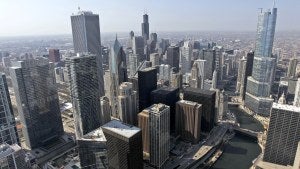How to Change the World: Why Quick Fixes Fail and What to Do
 Play Podcast
Play Podcast
About the Episode
Dive into the world of lasting change with Deep Dish! Join host Brian Hanson and author Sascha Haselmayer in a captivating exploration of 'The Slow Lane.' We’ll uncover the secrets behind why instant solutions often miss the mark, and how embracing patience and strategic thinking can pave the way for sustainable transformation to address global challenges.
- The Slow Lane: Why Quick Fixes Fail and How to Achieve Real Change, Sascha Haselmayer, Berrett-Koehler Publishers, July 18, 2023
- Serving the Citizen—Not the Bureaucracy, Sascha Haselmayer, June 17, 2021
[Brian Hanson: INTRO: This is Deep Dish on Global Affairs— going beyond the headlines on critical global issues. I’m your host, Brian Hanson, with the Chicago Council on Global Affairs.
In a world filled with grim news, this week we want to look at successful social change – times when real, sustained change is achieved in ways that have transformed systems and produced a better future for everyone affected. What lessons can be learned and spread to help bring genuinely transformative change to the most important challenges in our world and our lives?
Our guest today, Sascha Haselmayer, is the author of the important new book titled "The Slow Lane: Why Quick Fixes Fail and How to Achieve Real Change." He challenges the conventional wisdom that big change requires massive disruption imposing new ways of doing things from the outside. Instead, our guest takes us on a journey through the secrets of genuine, sustainable transformation. So, how can we navigate the complexities of societal challenges, and embrace patience, persistence, and inclusive strategic action to create meaningful progress for people, communities and our world?
Sascha is a nonresident fellow on global cities right here at the Chicago Council on Global Affairs. He is a social entrepreneur who has led urban innovation, economic development, and government innovation projects in over 50 countries. He is a senior leader at the Ashoka organization, and he has advised organizations such as the Rockefeller Foundation, Bloomberg Philanthropies, the Aspen Institute, and the World Bank. Sascha starts off by sharing why he wrote “The Slow Lane”, and the concept of Social Entrepreneurship…]
Sascha Haselmayer: It really was a book to draw the attention to this really abundant resource in society that many city leaders and others don't see. And those are social entrepreneurs, about 50 million people around the world self identify as someone who is building a movement or an organization, to solve a societal or environmental problem. That's almost one in a hundred adults in the world. And yet in my experience in working alongside city leaders. we didn't have that category when we looked at who we were working with from inside government, we were working with traditional charities or faith groups, and we were working with corporations and in the last decade or so, increasingly talking about startups. And the quick fix was really to say, look there's this low hanging fruit, this relationship, 99 percent of social entrepreneurs say they fail when they try to work together with the government and are increasingly resentful as a result and then end up working around rather than with leaders in government. And what brought about the change towards writing a book that is called “The Slow Lane: why quick fixes don't work” is really a recognition that most of these social entrepreneurs I talked to were saying that the government is too slow and they felt rejected. And then when I investigated what leaders in government in those same stories we're experiencing, they actually said, oh, we never said no, or they said, our rate of change is different. And the challenge I had was, and this was really tearing me apart from the inside, is that on both sides, I met the same great creative people who were doing the best they could to transform systems and communities. So, it seemed like they were in a bit of a collision course despite the fact that really what I was seeing was great people all around. And then to reconcile these two worlds, I kind of did a bunch of inner work, looking at my own journey as a social entrepreneur, working alongside a lot of mayors and city leaders. And, what I found there was really that it wasn't so much where you are institutionally. It was more a matter of how you are including citizens and especially disadvantaged groups in this journey. And that's really largely a matter of speed. You have to slow things down to be inclusive, and what I then found is those social entrepreneurs who succeeded in delivering this transformative change were building things intentionally slow and holding their urgency to get things done fast to bring everyone along and the same applied to leaders in government. And so really the quick fix, so to speak. I think the opportunity is still there to connect the dots. But I think we have to let go of the idea that breakneck things, breakneck speed will get us to the result we need, and we need to stop thinking of challenges like the climate crisis moving at unstoppable speed towards us, which really just forces us sometimes to act faster and less complex than might be needed.
Brian Hanson: And I want you to unpack a little bit more about what you find about these, quote, fast lane approaches, which tend to have the characteristics, as you describe them, of, wanting to do something quickly in order to produce a solution. And you talk about this leads to a certain pattern of approaches but in terms of who gets to decide things, what results, could you lay out a little bit about what you see as some of the common pitfalls of these fast lane approaches?
Sascha Haselmayer: In many ways, the most memorable laboratory of this was the global financial crisis in 2008. At the time I lived in Barcelona and what I really experienced in real time was how a government was closing itself in surrounded by economists and financial advisors from European and international financial institutions academics who were basically Hammering out a plan to quickly restore the old order, and they were closing themselves up at what I think we all recognize at a moment of fear or crisis, we are not going out presenting the world, our problems and inviting others in. We try to kind of ideally sweep it under the rug and make it go away. And, what they came up with in those closed rooms. Is a bailout plan for the banks that was coupled with really draconian austerity measures. These are severe budget cuts. And so, in a country that was already in fast economic decline. rapidly rising youth unemployment, you were then cutting social services, community services and at the same time, you were bailing out financial institutions to restore the previous order. And I think what leaders lost sight of there in all this kind of engineering, because what you end up doing in a kind of fast lane scenario like this, you end up trying to solve a big complex problem. With a simple, big move, like the one move that frees you up, right? Millions of families were thrown into extreme poverty and inspired by the Arab Spring that had happened just before. Young people and citizens in Spain who had been politically very unengaged congregated on the squares of Madrid and Barcelona, what became known as the Indignados Movement. They built a camp and they wanted to be heard because to be heard meant to be seen they didn't know what else to do and this by the way sparked the global occupy movement so this played out in a thousand cities around the world everywhere and of course, we know the aftermath of this the political aftermath in Spain the two dominant political parties that shared 97 percent of the vote we're reduced to rubble effectively and we're out of power for many years change the political landscape completely. And so, the resentment against these fast lane actions, this big liberating move that somehow lost sight of how big the damage was going to be to society, just really caused a lot of trouble politically, so it wasn't really a successful political game. And it's certainly the pain is just far, far, far too big a price to pay for what the government had intended. And that for me is kind of like a typical story that embodies this kind of fast lane playbook, right? Lock yourself up, act fast, and get it done.
Brian Hanson: It's such a great example because the other thing is I'm guessing lots of listeners are saying, well, of course, I mean the global economies hanging in the balance. Is there any real choice to be made about how we do this? So, as you think about the slow lane approach, could you offer an additional example of a big kind of moment at which the slow lane approach was successful in one of these situations where there was a crisis that called for or seemed to have so much urgency behind it.
Sascha Haselmayer: There are, of course, as the resilience experts in the audience will know this language, there are crises that are shocks, like the financial crisis things that suddenly explode in our hand, and we have to find a way to respond them. And then there are crisis that are stresses, right? Long brewing injustices that are moving towards a point where the damage becomes ever more painful and of course, the way this plays out is different in the financial crisis. I think Iceland offered an alternative. Iceland was moving exactly down the same path Spain, and the president said, stop, we need to bring this to a vote with the citizens of Iceland because he somehow. Not just intuited, but seeing the numbers, the size of the bailout, he realized it would throw generations of Icelanders not just into poverty but also into debt. And he said, we need to call a referendum, and Iceland called a referendum. The citizens of Iceland rejected the bailout. They started a constitutional reform process and all kinds of other things happened, but actually without bailing out the old system and restoring an old order, they created something new and youth unemployment within two years was back to where it was before the crisis. So, I think that's just a counter narrative, right, of how actually what seems impossible at the time to take this to your citizen turns out to be a much faster way to get to the right place. In the book I talk about longer and slower brewing problems, right? The multigenerational effort off indigenous people in the Navajo Nation in the tribal areas in the United States, restoring their food system, rebuilding community well being. And ultimately toppling a tax on healthy food and replacing it with a tax on junk food in the area. And I think it's such a moving story because describes a multi generational struggle to tackle all kinds of systemic injustices. It shows how a community is organizing itself, investing in what unites them, the families, their children, the pandemic of diabetes among young children. That is unacceptable and how young children were pleading to tribal council leaders. So, it shows just how a community organizes and achieves these transformative changes against all odds, but also, you know, finding a path through an almost insurmountable stack of problems that need to be solved to really restore not just health, but also their dignity and their culture.
Brian Hanson: And one of the things that's really striking in your argument is, the shorthand is the slow lane, but as you mentioned already, the time is to follow a certain set of principles and engage in a certain set of activities in order to bring about change. Could you use that Navajo example to illustrate what some of those principles are that led to such a positive outcome?
Sascha Haselmayer: Yeah, so there, there are five principles, that I identify when I look at over a hundred movements that we're doing and achieving, these outcomes. And the first principle is simply, and it's painful, it is to hold the urgency, right? Imagine yourself not just as a political leader in a moment of crisis, but as someone. Who's experiencing 30, 50 percent rates of diabetes amongst young children. You know, this is urgent. The key thing here is that holding the urgency is not sitting back and waiting for things to happen. It's incredibly painful. And our psychology and everything inside of us tells us, let's jump to action. Do something. So, what happened there in Navajo Nation? Denisa Livingston, one of the organizers of their community. She didn't just go out and petition for change and use her relationships to change something, but she mobilized the community, the families for years and generations. They've been of service to one another. To build the trust and build a kind of human relationship that allows new answers to emerge. Every time they looked at a political win to replace the law, they looked at how do we make this inclusive? How do we listen to everyone? So that in the end the win doesn't feel like a win over someone else in opposition, but something everyone including the political leaders achieved together and that's a mindset, right? And that mindset then allows you to also let go of this idea that someone has to be the smartest person in the room. Someone needs to hold all the ideas and come up with a perfect plan, in her case it was to let children speak at the tribal council, to build that emotional connection, to give an expression to this support network that families were developing. And so, sharing the agency in a way where a nine year old girl has as much power as the organizer create answers and to negotiate answers was really important. The fourth principle is what I call nurturing curiosity, it is very easy for anyone who organizes communities or around challenges to insist that there's only one answer. And Denisa Livingston is a wonderful example of this. She is as much a community organizer who will take part in community harvests and restoring food culture and dealing with family emergency, situations in our community as being tapped into a global network of scientists in public health. She is on the council of the slow food movement that has an indigenous, big indigenous movement to restore. indigenous food cultures and systems, and she is linked to social entrepreneurs and movement organizers like herself around the world, and she kind of embodies in a way both the permanence on the ground as well as a connection to science, technology, the arts and expertise from around the world. And she is feeding that into her community and that allows them to constantly look for new answers. And the challenge is sometimes the solution we really want becomes, for example, politically loaded. And then it becomes impossible to take action. As a community and invite others in those who were maybe your opponents, only a month ago and design new answers together with you and give them real power to co create. And so, this flexibility through curiosity, I think is incredibly important and not getting hardened on just locked in on one answer. And then the last principle is to use technology as an enabler. Oftentimes we think of technology as a way to dominate markets. That's the ultimate fast lane, of course, but also as a way to standardize human relationships and reduce complex human relationships steer around them because technology isn't good at that. And instead do what scales for technology. And in Navajo nation and in the DNA community, what they're doing is they use technology to power these human values and relationships. And this is what I've seen in movements all over is that they build a network of human relationships and values, and then they use technology to augment it, but never the other way around. They don't design the social network and then squeeze everyone in, but they see how the human relationships are evolving. And when they're firm enough, they're beginning to use technology in classrooms to teach advanced skills or to introduce new modes of working or collecting data, into those relationships.
Brian Hanson: that set of principles is really interesting. And I want to dig into them a little bit because on one hand one listens and nods their heads. But as you think about them, you can imagine some challenges. So, one of those is that you talk about the importance of inclusion. And the Navajo example is a great example of the people who are suffering from the problems are brought into the decision making process. I think many people say, okay, yeah, fine. You found one example of that, but I think a common mindset is usually. When, people who are disadvantaged are brought into a process, that's not about solving. That can just be about we want stuff out of this process, right? And it is this division and you're just handing power to another set of folks who are trying to serve themselves and you're not going to get to that collectively positive outcome that you the Navajo, example. Why is that? Why do you think that's the wrong way to think about this?
Sascha Haselmayer: Yeah, I think there are a number of mindsets have to challenge that I think all of us carry and in the book, I write about my very personal biases and how long it takes to recognize them and then find ways to work around it. So, I think the first mindset is, and it's the real fast lane mindset is, those who are in charge deserve to be there. Because they're somehow more expert or more gifted to be there. And it is very hard from a position where you think I'm smarter than the others. Or I have more access to knowledge. Or I'm a better person to plan strategies or interventions. The challenge there is that it's then very difficult at the same time to say I really want to involve people. Especially people with lived experience. So, the 1st thing that happens is, those most affected don't show up when we ask input, right? In one story, I recount the listening took more than 10 years in the case of a waste pickers in cities in Peru. It took more than 10 years, and listening there isn't just sitting there and waiting for people to say something, but it's actually working with them to solve what is on their agenda right now. If it is their survival from one day to another, you need to solve for that and assist them with kind of getting to a place where they can even think beyond just pure survival. In other cases, in Brownsville, in New York, it similarly took about 10 years because people had a very loaded history of how they were treated and underserved by government. And they were skeptical.
Brian Hanson: And this is a homeless population primarily?
Sascha Haselmayer: And no, it wasn't a homeless population, but it was a population that was primarily black and, in the 1960s, try to contribute to the school system and take co decision roles supported by a mayor, but then ultimately shot down by the teacher’s unions. And that echoed for generations. Their attempt and their invitation to participate and then being rejected. So, building trust is one thing, and if you do create the pathway for them to find their voice, they will also find their creativity by the way, and they will find their expertise. Peru, it was the waste pickers themselves who ended up rewriting national laws on health and municipal waste legislation and oversaw the implementation in 1,800 municipalities. They were fully capable to doing that. It just took a couple of decades for this group to get to a point where they could make that contribution. So, I think the idea that somehow, who we're inviting is not capable is challenging. And the other is that somehow, oh, all we need to do is open the door or invite them. That invitation has to be confirmed. We like to say at Ashoka, we like to say we want a world where people feel invited and capable. It's not our judgment to say how capable you are, how invited you are. It's the feeling you carry that actually this is a world that invites me to contribute.
Brian Hanson: Those are fascinating examples. And they're fleshed out in much more detail in the book. And I encourage people to go, read them because they are fascinating. I This point about creativity you make, how does that happen in a big collective situation? Right? Our common example of creativity living through the revolution of all the tech interventions in our lives is it's the one brilliant entrepreneur who sees a problem, sees a different way to solve that problem, and then implements that, really quickly. And part of that narrative is this idea that there are these entrenched systems and the only way to get change is through this kind of massive disruption. Could you give us a sense of how is this creativity unleashed through a process like this? and what's an additional example that really kinda gets at how positive creativity can match that deep change that great leader kind of narrative?
Sascha Haselmayer: When we think of these heroic leaders, right, like Jeff Bezos and Elon Musk and Mark Zuckerberg come to mind as people who are the great disruptors of our time. And, what I found is the startup playbook of break things, ask for forgiveness later. We've seen what happens when we say, look, we've only got one and a half billion Facebook users. let's. Keep tolerating hate speech and political manipulation for a little bit longer until we've reached two or three billion. Right? So, this idea that you will somehow ask for forgiveness later and then restore the damage you have done or somehow fix things or deal with the complexity later, it's nearly impossible to do that after the damage has been done. So, you think about how audacious are these ideas, really, they talk about spreading technology around the world and they talk about spreading a business model that is funded through advertising around the world. But actually, the damage it has done is significant to our democracies, to groups that are, experiencing. Down to genocide, just about any kind of abuse that is enabled by these fast growth platforms. So that's kind of, you know, in many ways, the model, so to speak, against we have to look at what the slow lane offers. Now, if you went to a venture capitalist and said, I'm going to end homelessness in 100 cities, no one would fund that idea. First of all, they wouldn't fund it because there's no business model in it. But secondly, they would say that's impossible. It cannot be done. What they would fund is someone saying, I'm going to build better and automated homeless shelters to deal with the growing homeless population. And so, one of the slow lane stories is about Roseanne Haggerty her movement in the 1970s working in a homeless shelter. Seeing that when she asked people what they needed, who came there for the night, they said, I need a job, I need a home, I need treatment and all she could offer them was a mattress. on a bunk bed, right? And realizing how ill-fitting the offer was to actually serve those needs. And then, fast forward, Rosanne and her Built for Zero movement are now on track to bring homelessness to what is called Functional Zero, meaning that as soon as someone enters the street or enters homelessness, their problem is resolved. In a matter of days in over 100 communities in the United States and the audacity of that idea didn't come because Roseanne imagined that in 1975. It came because she practiced together with people in the system, improvements to supported living to actually building a shelter system that wasn't a sheltered system but supported living that dealt with all the other needs of people to reinsert into society. And then she spotted an opportunity, less than 10 years ago and said, I think we can end homelessness, and I call this the practice of social imagination, because it's really not something that someone has this brilliant idea, but it comes out of practicing, solving the problem, being of service in the community as a form of listening and then letting people bring their ideas. And dreams of what is possible and ultimately the only solution to an injustice is to end the injustice. this is a pattern we see over and over that if you bring people to the table in this way, if you are making improvements and you stick to it rather than delegating it to automated policies, but you keep kind of the creativity going in this kind of collaborative effort. Incredible things happen the same thing. No one would have believed Albina Ruiz in the late 1970s that she would turn waste pickers into recycling professionals running municipal waste management contracts Never mind that this young girl from the Peruvian rainforest. Would become the minister for the environment to me, the question of where do the really audacious ideas come from. It's shifting, right? Because we're no longer saying, Oh, it's these amazing superhumans or superheroes. It's actually everyone really can do this. And the other part is also they get the job done because I couldn't think of a single startup that I could say unequivocably. Has transformed a global system for the better without creating also then the side effects of hate speech or division or abused labor or all the other things we're seeing.
Brian Hanson: As we bring in a conversation to a close, I want to bring this up. Even one bigger level. We've been talking about specific problems that are addressed in this way and can be successfully addressed and bring about sustained change that benefits society as a whole. But you also have a chapter... that takes this to the problem of healing democracy. And I think there's a broad feeling that democracy is broken. It's not functioning, in a way that's responsive to people and producing the kinds of results that we want it to. How can this slow lane approach, help heal democracy?
Sascha Haselmayer: What I found remarkable is that people learned this by doing, by failing and. By, I think, ultimately having a very deep trust and care for human relationships. and I think this was something really important because this way of solving problems doesn't guarantee result, right? It doesn't mean the 50 million people who are building movements for social change are succeeding but adhering to these principles. keeps bringing people who are often excluded from our democracy, who are talked about but not included, it brings them closer to the center to become part of the decision making process, right? These children in Navajo Nation, who are speaking up in the Tribal Council, they are part of a better democracy. Because they have a voice they're seen and they know how to use their voice and they know how to be heard and this happens all along, it happens in Brownsville where families are holding New York City public services accountable. Using after 15 years now using advanced data practices to do that, it brings them closer to practicing the full set of democratic tools and not just being a voter. it's really important to acknowledge that this path may seem, risky because you don't know where you're going to end, but actually all the while you're seeding something that looks different from the door to door politics in a way we do around elections, right? Where we knock on a door and say, are you with me or against me? Or have you not made up your mind? And if you're against me for that moment, you're no longer my neighbor, right? You have no function. If you're with me, okay, I have you. And if you're undecided, I'll give you my little pitch. But Denisa Livingston Navajo Nation, she doesn't approach families by saying, are you for or against diabetes? Are you for or against a junk food tax? She does what neighbors do. She brings her community together to improve lives and build deep trusting relationships that have nothing to do with politics as a divisive means. And I think for me, the most powerful example of this is how deeply Catholic Ireland. Managed to deal with draconian abortion laws without political leaders ever using it in the divisive way we've seen it in the United States and other countries And I think Ireland did this. Because the Republic of Ireland is next to Northern Ireland and they have seen what happens. when you go too far, they've seen the victims, they've seen what it does to a society if it goes too far. And I think it's a really powerful story to see how we can hold back on our urges to play the quick wins, to use. Politics of divisions and really the slow lane is an answer to that saying you can do incredibly powerful and transformative and constructive things without dividing your community without seeding this lasting division and damage.
Brian Hanson: I think one of the things that's so powerful about that story as you tell it in the book is it's not that there was unanimity, where everyone in the country thought the same policy made sense, but there was a process by which it came to the conclusion And I think one of the interesting things about that story, it was about a stable political resolution even in a context when there are people who very strongly disagreed with where the policy came out.
Sascha Haselmayer: That's absolutely true. And I think it was deep and surprising set of actors in the end that came forward social scientists who were concerned about and think about how this resonates today. They were concerned about the quality of political discourse in the country and thought about, how could deliberate forms of policymaking involving citizens, raise the quality of discourse and they had been tinkering with that. It was about individuals like Catherine Zappone who. as a theologian happened to be an independent member of cabinet and so to speak, was able to nurture the kind of spiritual conversation of acceptance to these very conservative leaders in the country to the reforms that the citizens had voted on. So, it's also maintaining that space and the possibility for these people to find a place in the process. and I think the deep underlying wisdom there was to never let discourse degrade to a point where that wasn't possible. And somehow everyone, retained that openness to new ideas that might help us work this out in an inclusive and participatory way.
Brian Hanson: Sascha Haselmayer author of "The Slow Lane: Why Quick Fixes Fail and How to Achieve Real Change." -- I want to thank you so much for being on Deep Dish to help us reshape our understanding of how social progress happens and for sharing your call to embrace the slow lane approach for the issues in our world. Thank you so much for being here!
Sascha Haselmayer: Brian, thank you very much for having me.
[Brian Hanson: OUTRO: Those And thank you for tuning in to this episode of Deep Dish. A reminder that we want to hear more from you, our listeners. So, send us an email or, better yet, a voice memo, to deepdish@globalaffairs.org You can suggest issues you’d like us to cover, guests you’d love to hear from, or you can just let us know how you think we’re doing.
And if you are looking for more Deep Dish in your podcast diet? Tap the “follow” button in your podcast app so you get each new episode as it’s released. If you think you know someone who would like today's episode, please "share" it with them!
As a reminder, the opinions you heard belong to the people who expressed them and not the Chicago Council on Global Affairs. This episode is produced by Kyra Dahring and edited and mixed by Frank McKearn from Aphorism Productions.
Thank you for listening. I’m Brian Hanson and we’ll be back next week with another slice of Deep Dish.]




Related Content
 Global Cities
Global Cities
Nonresident Fellow Sascha Haselmayer discusses his new book, which synthesizes the lessons he learned from his work with cities, governments, and NGOs.
 Global Cities
Global Cities
Chicago is known the world over for its bold and unique architecture. After all, it’s the birthplace of the skyscraper. But how does the city compare globally when it comes to sustainable architecture?
 Food and Agriculture
Food and Agriculture
A "sustainable food seal" empowers consumers and farmers to support a more sustainable food supply chain.
